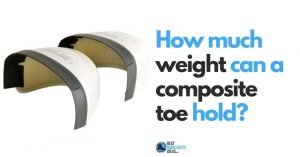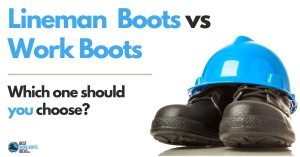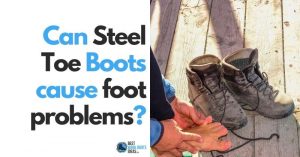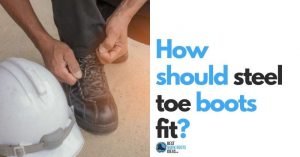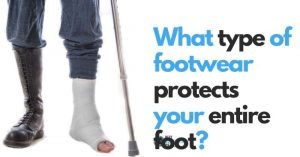What is a Soft Toe Work Boot and i it for You? 5 Things You May Not Know
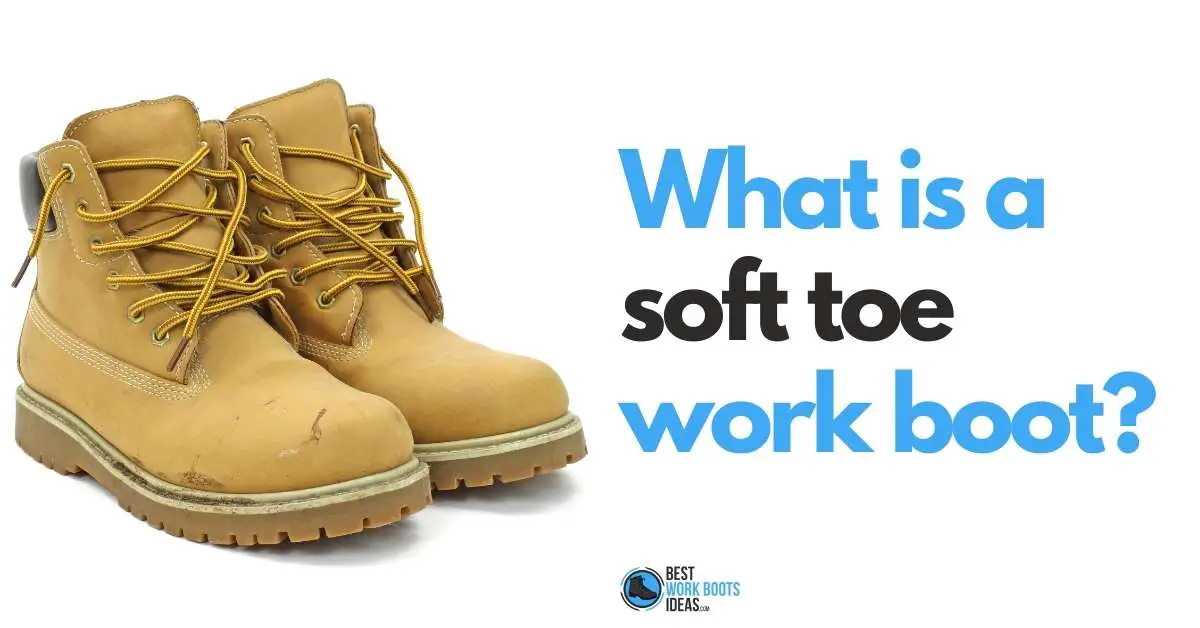
When talking about work boots many people assume that all work boots have protective toe caps.
This is not true, and there is an entirely different style of boot called a soft toe work boot.
They might look the same as their safety boot cousins, but soft toe boots deliver a different experience with different features.
There are benefits you will get from soft toe boots that can’t be matched by safety boots.
There are also some risks associated with wearing them.
In this article we’ll get into all the reasons you might or might not want to pick up a pair of this style boot.
Full disclaimer, I am a person that wore soft toe boots to his construction job.
I owned a residential contracting business, and there were no OSHA inspectors popping in for a surprise visit.
I worked for years wearing soft toe boots and never once had any issues or injuries that made me think twice about the footwear I used.
To be clear, there are some jobs for which soft toe aren’t only inadvisable, they’ll also get you in trouble with your foreman.
This article is meant to be a guide to help you decide whether or not soft toe boots are something that would benefit you.
Let’s get into breaking down this topic.
Contents
What Would I Get Soft Toe Work Boots For?
Soft toe work boots are perfect for occupations in the trades, but couldn’t be considered industrial work.
Painters, residential contractors, and gardeners are just a few of the positions I can think of off the top of my head that would benefit from soft toe footwear.
This style of work boot lacks the traditional toe cap found in safety boots, but it makes up for it in other ways.
Traditional in the sense of steel toe, composite and alloy toe.
Most of the features you’ve grown accustomed to in your steel or composite toe boots can also be found in soft toe footwear.
Slip resistance, shock absorption, and a comfortable fit are all things you can find in a good pair of soft toes.
They should in no way be considered the lesser of the boot categories.
If flexibility, mobility, and comfort are top priorities while on the job you should definitely give soft toe a look.
Also, grab a pair if you work in an occupation where electrical hazards are a frequent point of concern; they’re perfect for that.
I met all of these conditions during my years as a residential contractor.
I’ll speak to you about my personal experiences, not simply what I’ve heard other people say.
Flexibility and Mobility
Soft toe boots allow you a range of motion that safety toe boots have difficulty competing with.
They’re also lighter on average, so your legs won’t tire as quickly when wearing them.
Both these facts are due to the fact that they don’t have a big chunk of metal (or composite material) in the front of the boot.
Toe caps can make walking cumbersome and your foot an unwieldy thing to navigate around.
Safety boots are designed with rigid toe boxes that limit the natural walking motion of a human being.
A study has actually shown that aside from injuries prevented directly by toe caps, the overall leg injury rate goes up when wearing safety boots.
How’s that for a soft toe endorsement?
I understand all that from experience.
I was often on extension ladders repairing gutters, shingles, and siding.
I’ve also spent time on rooftops installing and resealing skylights and exhaust vents.
Even indoors, at comparably low heights of 6-8 feet, I was on ladders installing and caulking crown moulding.
In all these instances, my primary concern was not something falling on me, but rather the idea that I would be the thing falling.
It was for those reasons that I wanted flexible footwear that allowed me to really feel my foot making contact with the ground.
I didn’t want a big toe cap preventing me from finding my footing.
There were plenty of times where my hands were full with whatever tools and supplies I needed for the job, and I couldn’t have my eyes on where I was stepping.
In these moments it was of paramount importance that I not be wearing boots that felt like bricks strapped to my feet, but rather boots that felt closer to the running or hiking shoes I wear in my non-work hours.
Electrical Concerns
Soft toe boots lack a metal toe cap, so you’re safer from shock hazards.
Metal conducts electricity, so limiting the amount of metal in your boot will limit your chance of shock.
This is of primary importance to electricians and linemen for the power company.
Not limited to soft toe boots, you will find that boots marketed as ASTM EH (rated for protection against electrical hazard) sometimes advertise that the eyelets and shank are also made from non-metallic materials.
(Just painting a full picture so you know there are safety boots that also boast a metal-free construction)
This may seem like an abundance of caution, I understand, I’ve felt the same way.
I’ve also seen completely unexpected things happen with my work and for the electricians I’ve worked alongside.
Thankfully, I never saw any serious injuries.
They all laughed and said “that’s why I never trust my memory of turning the circuit off.”
Beyond those workers who know they’ll be handling electrical currents, there’s all the ones like myself who just encounter wires as a surprise from time to time.
I might not have thought of this at the time, but wearing soft toe footwear was a big plus in those moments.
Being a contractor requires you to use your body and feet in a number of ways.
In many cases, you’re tearing apart and walking into the skeleton of the house.
There are countless times that I demolished some drywall and realized there was an exposed wire poking through the studs or their footer plate.
I could write for several thousand words about all the times I saw electricity I wouldn’t have expected.
Suffice it to say, I saw enough to know I didn’t want to lead with a big hunk of metal strapped to my foot.
I understand that many people who work with electricity are also required to get boots that meet OSHA standards for a safety toe.
If this is you, soft toe boots are definitely the wrong call, and you’d be better served with a composite toe boot that is OSHA approved.
A major part of being safe on the worksite is predicting all the things unlikely to happen and getting yourself suited up as though it will absolutely happen tomorrow.
If you put together all the little things that can make you marginally safer (gloves, safety glasses, ear protection etc…) you will have made your work notably safer in the long term.
Comfort
Soft toe boots are generally more comfortable than comparable safety boots. This can be for a number of reasons.
First, the lack of the toe cap allows more room for your toes to move.
The designers don’t need to worry about how to fit a toe cap into the boot, so they can just worry about your foot.
This isn’t only about comfort, it’s about your health as well.
Corns, calluses, and neuropathy have been linked to ill fitting shoes.
An Australian study conducted found that 91% of those wearing safety boots have foot problems as a direct result of their footwear.
Secondly, when manufacturers aren’t worried about passing ASTM tests, they promote comfort.
This is more a market force than science, but if the free market competition means I get more comfortable boots, I’ll take it.
What do I mean by that? When selling safety boots, the manufacturer obviously leans into talking about how safe their boots are. Makes sense.
Without that as a selling point, what can they offer?
Well, they have to offer things like padded collars and vamps.
Breathable and moisture-wicking liners. Shock absorbing and energy returning mid and insoles.
These are all features that you can find in safety boots, I admit.
That said, I’ve found in my research that soft toe boots provide these comfort features in abundance.
Safety boots usually leave one or more out as they’re focused on the toe cap, puncture resistance, etc…
Who Should Avoid Soft Toe Boots?
Simply put, if your job requires OSHA approved work boots you should avoid soft toe boots.
I would also say that if you carry heavy and dense objects (like a mason), you’d be better served with a safety toe.
It’s also not wise to have soft toes when heavy construction machinery is rolling around all the time.
With all that in mind, there’s a lot of personal preference involved in this debate.
You may be interested in reading our comparison of steel toe vs soft toe work boots.
I’m sure I could find people that would call me crazy for doing the work I’ve done without a safety boot.
I determined that the risks associated with a heavier, stiffer, electricity conducting boot were greater than a boot without a toe cap.
Do your research, consult your PPE manual, consider what your work looks like, and decide what best suits you.
Everyone’s life, and work are different.
Wrap Up
Next time someone asks you what is a soft toe work boot, I’m hoping you’ll be able to answer with some level of confidence.
Although soft toe boots have no real toe protection, they still offer comfort and durability like most other work shoe.

